Life After Nesting, Part 2

A Tree Swallow’s entire life after nesting is focused on staying alive until the next year’s nesting season begins. We’ve discussed two important aspects of Tree Swallow post-breeding existence, assembling in large flocks and moving south on migration. Now let’s cover two more essential parts of Tree Swallow life, feather molt and wintering.
What is feather molt and when does it take place in Tree Swallows?
- If you are able to get a close-up look at Tree Swallows between July and November you may be surprised at the odd patchy appearance of their plumage, for this is the molting season for this species.
- Do the birds in the photos above by Allen Chartier and below by Jeremiah Trimble bear much resemblance to the ones that nested with you? Believe it or not, they are both Tree Swallows, and both are somewhat less than half-way through their molts.
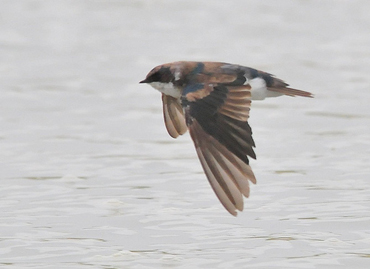
- Feathers get a lot of use, especially in birds like Tree Swallows that seem to live on the wing. After awhile they become so weakened and worn a new set is needed.
- Molting is the gradual and systematic replacement of all or portions of a bird’s old feathers by new ones. In songbirds molt of flight feathers takes place gradually so they can continue to fly.
- Molting is “expensive” for songbirds. Replacing old feathers with new takes lots of raw materials and energy, plus it can be harder to fly and keep warm when some feathers are missing or only partly regrown.
- Because it does demand lots of energy to grow new feathers most birds molt when nothing else major is going on in their lives, for instance, not during nesting or during migration.
How many times do Tree Swallows molt in one year?
- Different songbird species have different timing and patterns of molts, and many species molt more than once a year. However, adult Tree Swallows have only one complete molt which starts as the swallows’ nesting season is ending.
How does Tree Swallow Molt proceed?
- The replacement of feathers during molt may look random but it’s really very ordered and sequential.
- The photo below, taken by Donna Carter in central New York State, shows an adult at the start of its molt in early July. Notice the typical notched appearance of its wings where the bird’s flight feathers are beginning to be replaced. Molt of the the primaries will proceed one by one from the mid-wing out to the wing tip, and replacement of the secondaries advances from the mid-wing in toward the body.
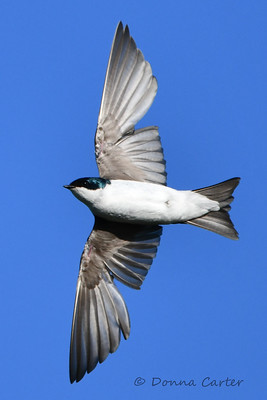
- Look closely at the photo and you’ll see new feathers beginning to push out into the gaps in each wing. An even closer look reveals bare spots at the molting flight feathers’ bases where small covert feathers have been shed.
- Tree Swallow molt of both body and flight feathers continues gradually during the lengthy, stopover-filled migration, and normally ends before the birds reach their wintering grounds. In this molt all adult males and both blue and brownish adult females will acquire iridescent blue head and upper body feathers.
- Juvenile Tree Swallows also have a complete molt that starts soon after they fledge. By October or November young males will have acquired the bluish AHY (after-hatch-year) coloration that will characterize them all the rest of their lives, and young females will wear the distinctive brownish SY (second-year) plumage they will have for one year only. (See Sexing and Aging Tree Swallows for more on this subject).
- Note the mix of old sun-faded wing and body feathers and bright new ones in the two photos at the start of this page and the one below from Birdfreak.com. These birds in mid-molt show the typical gradual simultaneous replacement of different feather tracts.
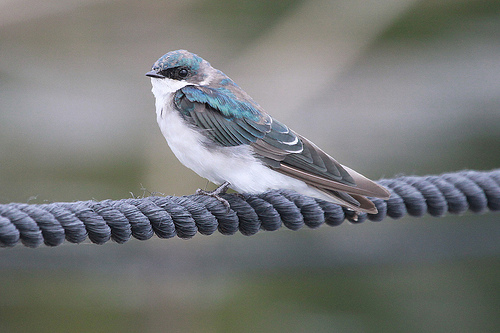
- It has been suggested that one reason Tree Swallows typically makes one or more long stopovers on southward migration is to allow time for the species’ gradual molt to progress to the finish before the birds reach the wintering grounds.
- For more on feathers and their importance see Bird Flight shown by Tree Swallows and Feather Care and Function.
Where do Tree Swallows winter and why are some flocks of wintering Tree Swallows so large?
- By late autumn most of the Tree Swallow migrant flocks have finished molting and have reached their wintering grounds.
- The majority winter in or near wetlands in Florida, Louisiana, and eastern Mexico. Lesser numbers winter in other parts of the southeast US, California, coastal Mexico, Central America and Cuba.
- Geolocators have determined that as many as half these swallows travel from one wintering region to another during the winter season. Competition for food and/or roosting opportunities probably drive these movements.
- Obviously, preserving the availability and integrity of these limited winter habitat sites is crucial for the species’ future.
- People witnessing Tree Swallows in large winter flocks may overestimate the species’ abundance. They don’t realize that in winter the entire population is very concentrated and vulnerable in these relatively very small regions.
- Contrast the huge spread of Tree Swallows breeding range (below left) with their very small mid-winter range (below right). Photos from eBird’s Tree Swallow abundance page.
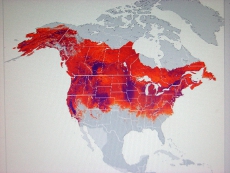
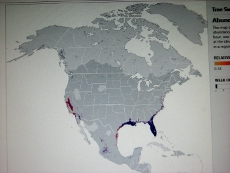
- People viewing large wintering flocks should also be aware that these are migration survivors. Many of the swallows that left the nesting grounds and started south are already dead.
- It’s believed that up to 85% of some songbird species’ annual mortality occurs on migration, not while nesting or wintering. Bad weather, predators, disease, and accidents all take their toll.
- Chris Wood’s photo below shows a Merlin carrying a captured migrating Tree Swallow in its talons.
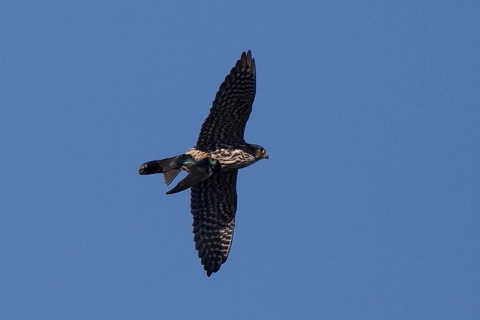
What is life like for Tree Swallows on their wintering grounds?
- For Tree Swallows daily life during winter appears to be much like that on migration stopovers. They rise from large roosts at dawn, spreading out in groups to feed, with intervals during the day spent preening and sunning. Then around dusk they return again to their traditional roosts.
- The photo below shows several huge radar rings created by hundreds of thousands of Tree Swallows dispersing from overnight roosts one February morning in Florida.
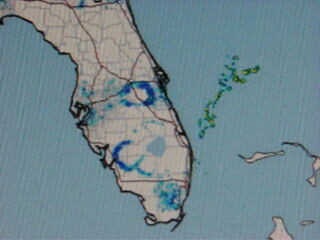
- And, as on the southward migration, waxmyrtle berries and bayberries are important food resources during winter. Here’s a link to Jill Kusba’s YouTube video of thousands of Tree Swallows feeding on waxmyrtle berries in Florida.
- However, not all Tree Swallows winter in the deep south. Some winters a few hardy ones try to tough it out along the Atlantic coast as far north as New England and Nova Scotia in the east. Out west some attempt to winter up the Pacific coast as far as Washington State. A few if these risk-takers occasionally survive to spring. As you might expect their ability to endure this far north depends largely on availability of bayberries and waxmyrtle berries.
- To get a sense of how a small band of Tree Swallows endured a northern winter read John Elliot’s classic report.
Is Tree Swallow migration north similar to their migration south?
- Eventually, the daylight hours lengthen in late winter and temperatures warm once again. In reaction, internal hormonal changes stimulate Tree Swallows to begin the return north to their species’ nesting grounds.
- However, migration north is different. For one thing many of the swallows that began the move south last year have perished. And instead of autumn’s great flocks, surviving Tree Swallows head north early in spring as individuals and small groups. Older swallows migrate first, followed a few weeks later by the younger, second-year birds.
- Prevailing spring wind directions may cause the swallows to follow migration routes north that are quite different from the ones they used moving south last autumn.
- And rather than a slow progression from roost to roost, Tree Swallows heading north appear to fan out across the continent rapidly. They make longer flights with much shorter stopovers, as they home in on locations where they nested in the past or where they were raised the previous year.
- Northward migration usually takes Tree Swallows 1-2 months instead of the 3-4 months the birds spend moving south.
- And Tree Swallows are notorious for migrating north extremely early compared to other birds that rely primarily on active insect food. The need to obtain a nesting cavity before they are all taken probably drives this early pattern.
Isn’t it dangerous for Tree Swallows to migrate back north so early?
- Yes, migrating north so soon is definitely dangerous. Both flying insect food and berries are apt to be scarce or absent. Death from starvation and hypothermia is a very real risk.
- Marty Burke’s photo below shows a flock of Tree Swallows in Ontario, halted by cold, snowy weather in early April. Note how the swallows have huddled together, desperately trying to conserve body heat. This is quite different from keeping their usual “individual distance” from one another.
- To learn more about the northern migration see this page: Tree Swallow Spring Return.
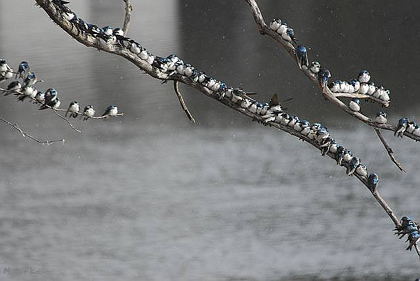
Will the swallows that nested with you come back?
- As we’ve seen migration and wintering have their own sets of dangers. Unfortunately it’s inevitable that some, perhaps many, of your birds, especially the younger ones, will have died before the new nesting season.
- However, banding has shown that adults, especially males, which have nested successfully in a location are apt to return. Female Tree Swallows have a lower rate of attachment to previous nesting sites.
- Banding has also demonstrated that young swallows entering their first nesting season usually return to the general area where they fledged. Individuals that were large and strong as nestlings have a statistically better chance of returning.
- So, yes, migration and wintering are very challenging. However, surviving adults who nested with you last year and young that they fledged should attempt to return north for another nesting season at your boxes. And other Tree Swallows, newcomers prospecting for places to nest, will probably arrive with them.
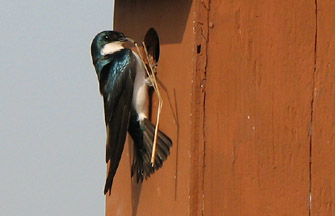
Question for the next topic: Nest Box Care and Season Assessment
- What things can you do after your swallows have gone?
——————————————————————————
Home: Tree Swallow Nest Box Projects
Creating Tree Swallow Nest Box Projects
Spring Return
Nesting Season Behavior
Song and Calls
Nest Site Claiming
Pair Formation
Nest Building
Bird Flight
Mating and Paternity
Diary of One Season at Salmon Creek
Monitoring Nest Boxes and Keeping Records
Making Box Checks Keeping Box Records Control Sheets Season Summaries Print Sheets
Banding Your Tree Swallows Banding Adults Banding Nestlings
Tree Swallows in Research Research Bibliography Glossary of Terms